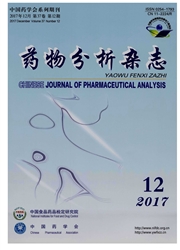

 中文摘要:
中文摘要:
目的:建立川芎药材活性部位的指纹图谱,为其定性鉴别提供依据。方法:川芎药材经乙醇超声提取后,分别用石油醚、乙醚、乙酸乙酯、正丁醇、水萃取,对乙酸乙酯部分在268nm,以60mmol·L^-1硼砂缓冲液(用硼酸调至pH为8.0)条件下进行分析,建立其指纹图谱。并对6种不同来源的川芎药材进行高效毛细管电泳指纹图谱定性分析。结果:本研究建立的分析方法的精密度、重现性较好,以阿魏酸计RSD分别为3.39%,4.76%;不同川芎药材指纹图谱中主要峰群的整体图貌基本一致,但各成分含量的相对比值有所不同,不同来源的川芎药材共有峰面积的比值及共有峰面积和均有一定的差异。结论:高效毛细管电泳指纹图谱分析法可简便、快速地鉴别区分不同来源的川芎药材。
 英文摘要:
英文摘要:
Objective: To establish an HPCE-fingerprint pattern (HPCE-FPS) for the active part of Radix of Ligusticum chuanxiong Hort. and make a comparative study of HPCE-FPS of six kinds of Radix of Ligusticum chuanxiong Hort. from different sources. Methods. The samples were extracted with ethanol by supersonic technique for 20 min, and extracted with ethyl acetate. The capillary (75μm) column was used as analytical column ,the buffer solution was 60 mmol· L^-1 borax buffer ( pH = 8.0). The applied voltage was set at 30 kV and UV detection at 268 nm. Results:The method was proved to be precise with good reproducibility and the RSD was 3.39% and 4. 76% using ferulic acid as the standard component, respectively. The chromatograms was similar, but the ratio of common peak's area of different samples was different. Conclusion:This method can be used to differentiate Radix of Ligusticum chuanxiong Hort. conveniently and rapidly from different sources.
 同期刊论文项目
同期刊论文项目
 同项目期刊论文
同项目期刊论文
 期刊信息
期刊信息
